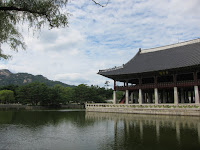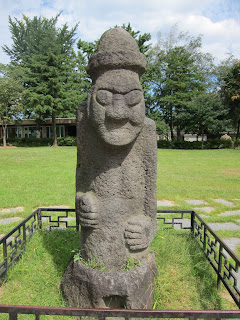On the way to the beautiful pavilions, I passed by this neat elevated hall. Not sure exactly what its purpose was but perhaps it was one of the residences for the royal family.
Nearby is the picture-perfect Hyangwonjeong Pavilion, also built in the middle of another lake connected via a lovely bridge known as Chwihyanggyo. The pavilion's name translates somewhat to "Pavilion of Far-Reaching Fragance" and while there weren't any discernible fragances nearby, the scene itself was certainly intoxicating enough to make you want to sit there all day to admire its serenity and beauty. I think if the sky was more blue that day and if the lily pads had flowers in bloom, I could literally sit here for hours and not be bored.
For those drama fans out there, at least two korean dramas (Tree With Deep Roots and The Moon Embraces The Sun) and I'm sure there are many more had some scenes filmed here
The National Folk Museum is also hosted on the Gyeongbokgung palace grounds and is built in various Korean architectural styles.
Outside the Folk museum, there were some musicians dressed in traditional garb playing folk instruments for an attentive audience.
I should also point out that there were some neat sculptures of the animals of the chinese zodiac nearby.
As part of the folk museum exhibit, in front of the main museum buildings was a replica of some traditional Korean village buildings. On the right is a statue known as a Dolhareubang, a stone grandfather sculpture found on Jeju Island and placed outside town gates to ward off the evil spirits. Certainly quite an eye-opener and reminded me of the Easter Island statues =P
The Hyojagak was a special structure used to protect a commemoration stone.
One last glimpse of the buildings in the Gyeongbokgung palace compound from the east gates before leaving for Deoksugung, the last palace of the day.


















No comments:
Post a Comment